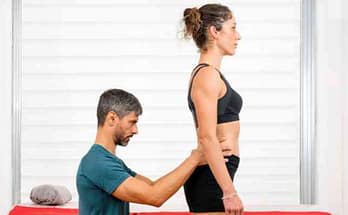Squatting with anterior pelvic tilt (APT) can be a challenge due to the postural imbalance that causes the pelvis to tilt forward. This condition can impact your squat form, leading to discomfort and complications, particularly when performing exercises like squats. In this blog post, we’ll explore the common mistakes to avoid when squatting with anterior pelvic tilt and provide corrective exercises and stretches to help you improve your form and reduce your risk of injury.
| Key Takeaways |
|---|
| Squatting with Anterior Pelvic Tilt (APT) can impact your squat form and increase the risk of injury. |
| Proper squat form is crucial for maintaining joint health, muscle balance, and reducing the risk of injury when squatting with APT. |
| Common mistakes to avoid when squatting with APT include insufficient warm-up, incorrect pelvic alignment, overarching the lower back, allowing knees to cave in, and neglecting core activation. |
| Corrective exercises and stretches for APT include hip flexor stretches, lower back stretches, glute activation exercises, and core strengthening exercises to improve your Squatting With Anterior Pelvic Tilt. |
| To squat safely with APT, you should monitor your progress, seek guidance from a fitness professional, adjust your stance, consider alternative squat variations, wear proper footwear, and use proper breathing technique for Squatting With Anterior Pelvic Tilt. |
| Addressing APT through corrective measures can improve your squat performance and reduce your risk of injury when Squatting With Anterior Pelvic Tilt. |
Understanding Anterior Pelvic Tilt (APT)
Anterior pelvic tilt is a postural condition characterized by the forward tilt of the pelvis. The causes of APT include muscle imbalances between the hip flexors, glutes, and abdominal muscles, poor posture habits such as excessive sitting with a rounded back, and leading an inactive or sedentary lifestyle. APT affects squat performance and can increase the risk of injury by placing strain on the lower back, hips, and knees.
Importance of Proper Squat Form
Executing a squat with proper form minimizes the risk of injury and maximizes its effectiveness. Proper form is achieved by maintaining correct spinal alignment, engaging the core and glutes, keeping the knees in line with the toes, and ensuring a stable base of support.
Proper form reduces stress on the hips, knees, and ankles, preventing injury. The muscles surrounding these joints are activated and engaged, which supports the weight being lifted. Without correct form, there is a greater likelihood of undue stress on certain structures, resulting in injury.
Proper form targets specific muscles effectively and avoids overloading structures prone to injury, making squats an efficient exercise for toning and strengthening the lower body, particularly the glutes. A squat assessment can provide valuable information about range of motion, flexibility, and muscular imbalances, tailoring a training program and reducing the risk of injury.
Executing squats with proper form also enhances the stability and strength of the low back and knees, helping prevent injury in other areas of the body. Overall, maintaining proper squat form is essential for achieving optimal results while avoiding injury.
Mistakes to Avoid: Squatting With Anterior Pelvic Tilt
1. Insufficient Warm-up
Warming up before you start exercising is crucial, especially if you have APT. It helps prepare your muscles and joints for the extra weight that your body will bear when squatting. Start with dynamic stretches and mobility exercises that target your hip flexors, glutes, and hamstrings.
2. Incorrect Pelvic Alignment
Keeping your pelvis stable and your spine neutral throughout the squat is crucial for good form. Make sure you’re in the correct position.
3. Overarching the Lower Back
Overarching happens when you push through your lower back instead of keeping it straight and rigid. This can put unnecessary pressure on your joints and discs, causing injury over time. Keep your chest out, shoulders down, and engage your core to avoid overarching.
4. Allowing Knees to Cave In
Keeping your knees aligned properly is crucial to avoid knee injuries. Keep your knees tracking over your toes and avoid letting them cave inward.
5. Neglecting Core Activation
Your core muscles help maintain stability and alignment when squatting. Engage your abdominal muscles throughout the movement to support your spine and pelvis.
Corrective Exercises and Stretches for APT
To correct APT, you need to stretch the tight muscles and strengthen the weak ones. Here are some exercises you can do:
- Hip flexor stretches
- Lower back stretches
- Glute activation exercises (like glute bridges or hip thrusts)
- Core strengthening exercises, such as planks
Tips for Squatting With Anterior Pelvic Tilt

- Monitor your progress by recording your squat form and making necessary adjustments to your posture.
- Seek guidance from a fitness professional to ensure you’re doing it correctly.
- Adjust your stance (e.g., foot width and angle) to find the most comfortable and effective position.
- Consider alternative squat variations, like goblet squats or box squats, to improve your form and reduce the strain on your lower back.
- Wear shoes that provide better stability, such as those with flat soles and minimal cushioning.
- Proper breathing technique is essential for maintaining stability during a squat. Inhale deeply before descending into the squat, then exhale forcefully as you push back up. This helps maintain intra-abdominal pressure and stabilize the core.
- Additional Considerations for Squatting With APT
- In addition to the above tips, there are some extra things to consider when squatting with APT:
- Use proper footwear to help you maintain proper form and prevent injury.
- Incorporate additional stretches and exercises into your routine to address APT and improve your squatting form.
Squatting with anterior pelvic tilt requires good form to avoid common mistakes and reduce the risk of injury. By focusing on your posture, incorporating corrective exercises and stretches, you can improve your squat performance and reap the benefits of this exercise. Remember to stay committed to injury prevention and performance improvement by consistently working on your form and incorporating the provided tips and exercises into your routine. Share this post with your friends and let’s improve our health and fitness!
Resources:
https://www.livescience.com/what-are-the-benefits-of-squats
https://www.webmd.com/fitness-exercise/health-benefits-of-squats
https://www.healthline.com/health/exercise-fitness/squats-benefits
https://www.healthifyme.com/blog/squat-like-pro-7-common-squat-mistakes-avoid/
https://www.muscleandfitness.com/workouts/leg-exercises/top-10-squat-mistakes/
FAQ
Can I do squats with weights while correcting anterior pelvic tilt?
Yes, you can do squats with weights while correcting anterior pelvic tilt, but it is important to start with light weights and focus on proper form before increasing the weight.
Can corrective exercises for anterior pelvic tilt be done at home?
Yes, many corrective exercises for anterior pelvic tilt can be done at home. However, it is important to seek guidance from a fitness professional to ensure proper form and to tailor the exercises to your specific needs.
How can I prevent anterior pelvic tilt from recurring?
You can prevent anterior pelvic tilt from recurring by maintaining good posture habits, avoiding prolonged periods of sitting or standing in one position, and continuing to practice corrective exercises and stretches on a regular basis.
How can I prevent anterior pelvic tilt from occurring while squatting?
To prevent anterior pelvic tilt from occurring while squatting, focus on maintaining a neutral spine and engaging your core and glutes. Additionally, using proper squat form, such as keeping your feet shoulder-width apart and your knees in line with your toes, can help prevent anterior pelvic tilt.
How does anterior pelvic tilt affect squatting?
Anterior pelvic tilt can lead to poor squat mechanics and increase the risk of injury. It can also cause discomfort and pain in the lower back and hips.
Are there any exercises that I should avoid if I have anterior pelvic tilt?
If you have anterior pelvic tilt, it’s best to avoid exercises that put unnecessary strain on the lower back and hips, such as heavy deadlifts and back extensions. Focus instead on exercises that help improve posture and strengthen the muscles that support the spine, such as bridges and bird dogs.




